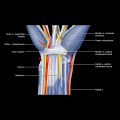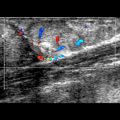Cystic Soft Tissue Mass
ESSENTIAL INFORMATION
Key Differential Diagnosis Issues
Helpful Clues for Common Diagnoses
 Most common cystic-type mass
Most common cystic-type mass
 Filled with gelatinous material of variable viscosity
Filled with gelatinous material of variable viscosity
 Occurs alongside joints
Occurs alongside joints
 Synovial fluid squeezed out from joint through capsular defect
Synovial fluid squeezed out from joint through capsular defect
 Usually can see cyst point toward nearby joint
Usually can see cyst point toward nearby joint
 Increase in extent through process of cyst enlargement → rupture → consolidation
Increase in extent through process of cyst enlargement → rupture → consolidation
 Fluid-filled mass with stalk extending toward joint
Fluid-filled mass with stalk extending toward joint
 Ovoid or irregular configuration with stalk connecting to joint of origin
Ovoid or irregular configuration with stalk connecting to joint of origin
 No hyperemia except with recent leakage when surrounding tissues may be mildly hyperemic and edematous due to pericystic inflammation
No hyperemia except with recent leakage when surrounding tissues may be mildly hyperemic and edematous due to pericystic inflammation
 Communication with joint is not always apparent
Communication with joint is not always apparent
 Locate tell-tale stalk of cyst and trace it toward joint of origin
Locate tell-tale stalk of cyst and trace it toward joint of origin
 Inflammation of lining of bursae
Inflammation of lining of bursae
 Synovial bursae: Constant synovial-lined bursae, which occur in defined anatomical locations
Synovial bursae: Constant synovial-lined bursae, which occur in defined anatomical locations
 Adventitial bursae: Nonsynovial-lined bursae that are acquired due to friction between opposing parts
Adventitial bursae: Nonsynovial-lined bursae that are acquired due to friction between opposing parts
 Synovial-lined space is not visualized on US unless distended with fluid
Synovial-lined space is not visualized on US unless distended with fluid
 Most bursae are accessible to US
Most bursae are accessible to US
 US facilitates image-guided aspiration or injection
US facilitates image-guided aspiration or injection
 Bursitis is common, but infective bursitis is uncommon
Bursitis is common, but infective bursitis is uncommon
 Chronic bursitis is often associated with wall-thickening and internal debris
Chronic bursitis is often associated with wall-thickening and internal debris
 Baker cyst = distended semimembranous, gastrocnemius bursa
Baker cyst = distended semimembranous, gastrocnemius bursa
Helpful Clues for Less Common Diagnoses



























